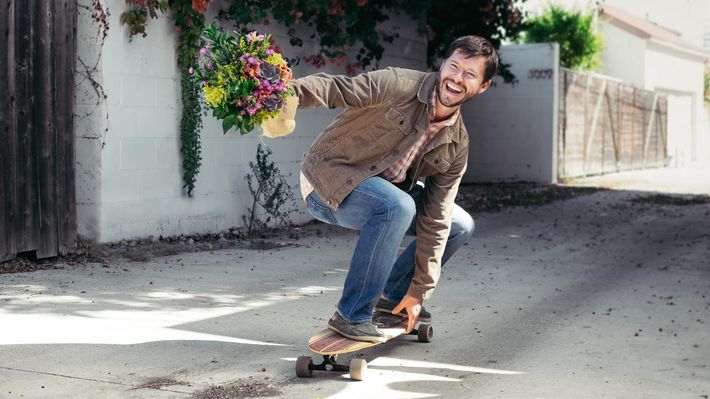29 May How Simple Mills Found Innovation In Their Employees’ Kitchens
 Many companies want to believe that innovation is a process that you can map out in a nice clean path. But Katlin Smith, Founder and CEO of Simple Mills, knows that more often, innovation comes about by mistake. I sat down with Katlin to talk about her journey building Simple Mills, how the company is leading the clean food movement, and why some of their best innovations have come by hiring people who share a passion for changing the food that we eat.
Many companies want to believe that innovation is a process that you can map out in a nice clean path. But Katlin Smith, Founder and CEO of Simple Mills, knows that more often, innovation comes about by mistake. I sat down with Katlin to talk about her journey building Simple Mills, how the company is leading the clean food movement, and why some of their best innovations have come by hiring people who share a passion for changing the food that we eat.
Dave Knox: Simple Mills was really an early entrant into the clean food space in 2013. What has changed over that time?
Katlin Smith: Well let us start with what Simple Mills does. We make baking mixes, crackers, and cookies out of very simple nutrient dense ingredients and do it in a way that delivers a really delicious product. If you think about a cheddar cracker or a cookie, instead of using a bunch of wheat, we things like almonds, sunflower seeds, or coconut sugar. We focus on the things that we want to be eating more of. We operate in these center store categories of the grocery store. What we’ve found is that we are serving this need for retailers because as more and more consumers switch to cleaner eating and recognize the connection between what they eat and how they feel, those center store categories have been in decline. People have been leaving the center of the store to shop in the perimeter, shop the produce, and get much more nutrient density in their diet. So, what we have really been doing is bringing consumers back to those aisles and providing solutions in those categories. The other thing that we have really seen in the past seven years since we launched, is that there are more solutions for people to eat well in the grocery store. And that gets me really excited because it means that overall people are eating better.
Knox: Those center aisles have traditionally been dominated by big food conglomerates that have very strong retail relationships. What allowed you to get past the traditional gatekeepers in retail and open their eye to the value of new brands and new offerings?
Smith: There are a few different things. One of them is that the problem itself is that people recognize that the food that they were eating was having a negative impact on their bodies, which really had a negative impact on that trust relationship that these large brands have with their consumers. So, they said, Okay, these products are healthy for you. They’re better for you. And then as people realized, oh my gosh, these same foods are the ones that are not making me feel great, that are having a negative impact on my health. It really destroyed that trust that was built between those companies and the consumer. And so that really primed the market for entrants like Simple Mills to come in and talk to consumers in a way that is much more honest and authentic.
The second is we built our team out of people who are passionate about this, who really understand this connection, and want to help change our food industry. And as a result, the insights that we have as a team are different than if we are just paying some large agency or research firm to figure things out for us. We already know the answer because we are the ones personally experiencing it. And this enabled us to accelerate innovation and solve problems in a way that is much more helpful to help them eat better. And that also translates into really people who are passionate and have a fierce commitment to our mission, which does help us move faster and break through boundaries and walls and do things that might seemingly be impossible.
Knox: How has innovation being at the heart of your culture helped you achieve this?
Smith: Culture is one of the very first places where it starts. It is about the people and the culture that you create within the four walls. By hiring people who were passionate about making this change in food, it enables us solve the problems quicker and to understand them with greater depth because we have those insights internalized. We do not have to learn them.
But it is also about continuously reinforcing this throughout the way you work as a company. For instance, for some time we tried to work with external food scientists. They would come back to us and say, “what you’ve asked for is not possible…you have to compromise on one of these things.” We decided to fill out innovation and R&D internally were the kind who think, “who says it is impossible. Let us figure it out.” Many of our greatest products came from our people moving without perfect information and leaning into that intuition.
But even with that, another tenant that we have is not compromising. If there is a product that we cannot launch without compromise, we are not going to launch it. There have been times in our history where the concept itself was a great one, but we had trouble meeting all our requirements. In those cases, we just said that we are not launching it instead of taking a shortcut that would compromise our values.
The strategy is usually the easiest part, it is the execution of that, that is really difficult. It is about not compromising on those tenants and making sure that the product does taste great. Figuring out how you satisfy all those things at one time is really the magic.
Knox: By hiring people who had a passion for the mission of clean food, has that led to any product ideas from their own kitchens?
Smith: All the time. Companies like to create this innovation process and say, “okay, you move from step A to step B, to step C, to step D and then magic at the end of the day, you have this product that consumers like.” But I don’t think that real innovation and creativity happens that way. It’s just sometimes a mistake. Take our new Veggie Pita crackers where vegetables are the number one ingredient. Those were inspired by the fact that our team was at home, trying to figure out how to fit more vegetables into their diet and asking where they can “hide” the vegetables in a pasta sauce or a smoothie. We asked the question, “how do you hide some vegetables in a cracker?” Then another one is our almond flour crackers. That one happened because I just took one of our baking mixes home one day and turned it into crackers for fun really. It wasn’t that we were trying to create a new product. It was just playing. And as a result, we developed our almond flour crackers. That play component is really important to innovation.
Knox: What advice do you give to entrepreneurs that are facing the journey that you started seven years ago?
Smith: Continue to learn and to be open to learning. When I first started out, I felt like I had to have all the answers, which is really just silly and naive. But that’s part of the reason why you have people around you to help you out. The more you can be honest about the things that you do not know, the better solutions you can create, the more you can learn, the faster you can learn.
Also as you build your team, there are always learning opportunities for leadership. Clearly communicate with the team, help them understand the path ahead, and understand the direction that things are going. There can be a lot of ambiguity and the ambiguity can create a lot of uncertainty as well as an inability to move for people. As a leader, you have the opportunity to clear things up.
Finally, learn to be flexible. That is a muscle that we are continuously flexing and making stronger as an organization. It teaches people that you do not have to have a hundred percent of the information to figure things out and to come to a solution. Things that are going to change in business. You have to quickly pivot and change. When people can do that, they feel a lot more powerful and that they can handle anything. It’s not the businesses that have never encountered difficult times or the people who have never encountered difficult times that are the strongest. It’s the opposite. It’s the ones who have encountered those things that grow stronger.
*This article first appeared in Forbes on May 20, 2020
Dave Knox has been recognized throughout the industry as an innovator who bridges the world between brand marketing, digital and entrepreneurship. Invite him to speak at your next virtual or LIVE event!










